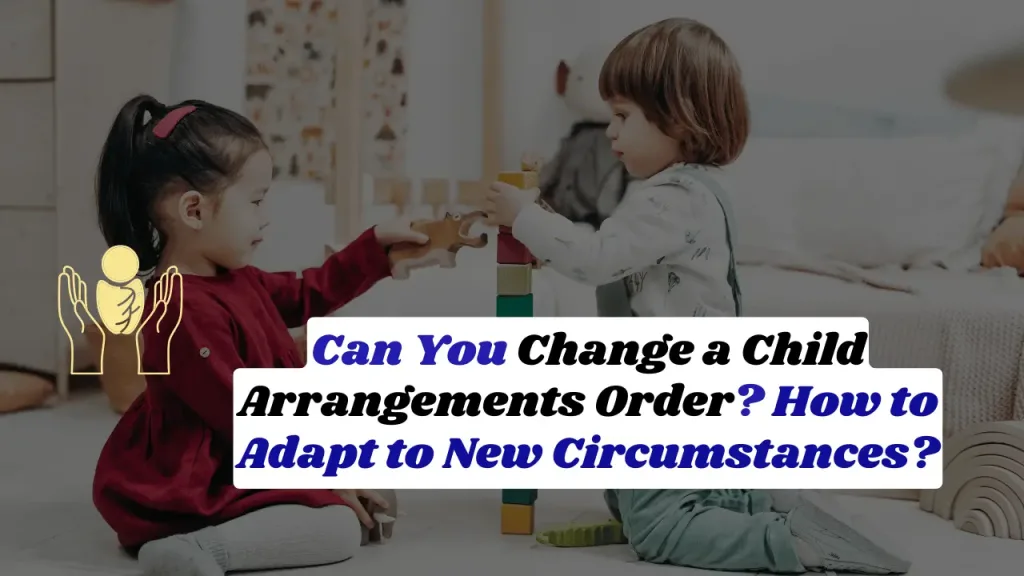Can You Change a Child Arrangements Order In UK? How to Adapt to New Circumstances?
When parents separate or divorce, ensuring a stable and nurturing environment for their children is a top priority. In 2022, over 52,000 Child Arrangements Orders were issued in the UK, reflecting the common need for structured parenting plans. However, as families evolve, these arrangements may no longer serve the child’s best interests, raising the question—how can parents adapt to changing circumstances while prioritizing their child’s welfare? This article explores how parents can modify a Child Arrangements Order and the steps involved.
Table of Contents
What is a Child Arrangements Order?
A Child Arrangements Order (CAO) is a legally binding decision made by the family court in the UK under the Children Act 1989. It determines where the child will live, how much time they will spend with each parent, and outlines other parental responsibilities. While the order is meant to provide stability, it can be modified to ensure that the child’s welfare remains paramount as circumstances change.
Why Might a Child Arrangements Order Need to Be Changed?
The primary reason for varying a CAO is the evolving needs of the child or changes in family dynamics. Common reasons include:
- Changes in the Child’s Needs: As children grow, their physical, emotional, and educational requirements can shift.
- Relocation of a Parent: A parent’s move may make the original schedule impractical.
- Work Schedule Adjustments: A parent’s job change might necessitate a new visitation timetable.
- Parenting Preferences: Older children may express a preference for more time with one parent.
- Safety and Welfare Concerns: New issues related to the child’s safety may arise.

Can a Child Arrangements Order Be Changed?
Yes, a Child Arrangements Order can be altered if justified by changing circumstances. Under Section 8 of the Children Act 1989, the court allows for modification to ensure that the child’s best interests are always the priority. The court considers:
- The child’s welfare.
- Significant changes in circumstances.
- The child’s age, maturity, and preferences.
How Do You Change a Child Arrangements Order?
There are two primary routes to modify a CAO: through an informal agreement or a formal court application.
1. Informal Agreement Between Parents
If both parents agree on the changes, they can amend the original order without court intervention. A written and signed agreement is usually sufficient, but seeking court approval can make it legally binding and enforceable.
2. Court Application
If parents cannot agree, a formal application to the court is necessary. This involves submitting a C100 form and attending a Mediation Information and Assessment Meeting (MIAM) to explore non-court resolution options. The court will use the welfare checklist from the Children Act 1989 to assess the application, considering:
- The child’s age and emotional needs.
- The likely impact of changes on the child’s well-being.
- The child’s wishes, if they are mature enough to express them.
Role of Mediation in Varying a Child Arrangements Order
Mediation is a crucial step encouraged in the UK to resolve disputes amicably before formal court proceedings. According to the Family Mediation Council, over 70% of mediated cases reach an agreement without requiring court involvement. Mediation helps parents focus on their child’s best interests, fostering cooperative co-parenting.
Types of Mediation:
- Parenting Mediation: Focuses on future parenting arrangements.
- Child-Inclusive Mediation: Allows children to express their views if they are old enough, helping tailor decisions to the child’s needs.
Do You Need a Solicitor to Apply for a CAO Change?
While hiring a solicitor is not mandatory, it is highly recommended. A solicitor can navigate the complex application process and improve the chances of a favorable outcome. Alternatively, a McKenzie Friend—someone familiar with the legal process—can offer support, though they cannot speak on your behalf in court.
Judicial Discretion and the Court’s Considerations
The courts have broad discretion when deciding whether to modify a CAO. They will weigh factors like the child’s welfare, parents’ wishes, and any practical challenges (e.g., relocation). Judges will consider a child’s feelings if they are mature enough to express a preference, as guided by Section 1 of the Children Act 1989, which emphasizes the child’s best interests.
Costs Involved in Varying a CAO
Changing a CAO can involve several costs:
- Mediation Costs: Typically around £150 per hour, though the Family Mediation Voucher Scheme may offer up to £500 for eligible families.
- Court Fees: A CAO variation application costs £255 for the C100 form.
- Solicitor Fees: Fees can range into the thousands, depending on the case’s complexity.
- McKenzie Friend Fees: More affordable than solicitors, usually between £30–£80 per hour.
Alternative Methods to Resolve Child Arrangement Disputes
There are several alternatives to formal court applications:
- Direct Negotiation: Parents discuss arrangements directly, possibly with a mediator’s help.
- Collaborative Law: Both parents and their lawyers work together to reach an agreement outside of court.
- Arbitration: A neutral third party makes a binding decision, offering a faster and flexible resolution.
FAQs About Changing a Child Arrangements Order
Can I change a Child Arrangements Order without going to court?
Yes, if both parents agree on the changes, they can create a written agreement and seek court approval to make it legally binding.
What if my child doesn’t want to follow the current arrangement?
The court considers the child’s wishes if they are mature enough to understand the implications. It’s advisable to seek mediation or consult a solicitor for guidance.
How long does it take to change a Child Arrangements Order?
If changes are made through mediation, it can take a few weeks. Court proceedings may take several months, depending on the complexity of the case.
Do I need to attend mediation before applying to court?
Yes, attending a Mediation Information and Assessment Meeting (MIAM) is generally required before applying to court unless there are safety concerns or specific exemptions.
What if my ex-partner refuses to follow the new agreed arrangement?
If one parent does not comply with an agreed modification, the other can apply to the court for enforcement or seek a formal variation.
Statistics and Expert Insights
- According to the Ministry of Justice, approximately 45% of family law cases involve ongoing disputes about child custody and visitation, indicating the prevalence of changes in child arrangements.
- The Family Mediation Council reports that 70% of families using mediation reach a successful agreement, avoiding the need for court intervention.
- Expert Insight: “Children’s needs evolve as they grow, and family circumstances often change. Modifying a Child Arrangements Order isn’t just a legal process—it’s a way to ensure that the child’s best interests remain at the forefront as life progresses,” says Rachel Spicer, a family law solicitor with over 15 years of experience in child arrangement disputes.
Conclusion
Adapting to new circumstances is a natural part of parenting, especially after separation. A Child Arrangements Order can be modified to ensure the child’s well-being as they grow and family dynamics shift. Whether through mediation, negotiation, or court proceedings, parents have multiple pathways to update arrangements. Always prioritize the child’s welfare when considering changes, and seek professional guidance to navigate the legal process effectively.
For more information, visit:
About the Author

Sarah Klein, JD, is a former family law attorney with over a decade of courtroom and mediation experience. She has represented clients in divorce, custody cases, adoption, Alimony, and domestic violence cases across multiple U.S. jurisdictions.
At All About Lawyer, Sarah now uses her deep legal background to create easy-to-understand guides that help families navigate the legal system with clarity and confidence.
Every article is based on her real-world legal experience and reviewed to reflect current laws.
Read more about Sarah
